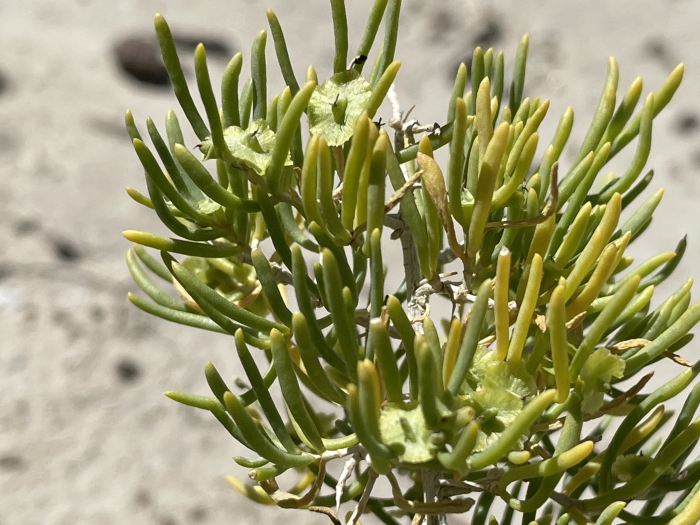Black Greasewood
(Sarcobatus vermiculatus)
Black Greasewood (Sarcobatus vermiculatus)
/
/

Bobby McCabe
CC BY 4.0
Image By:
Bobby McCabe
Recorded By:
Copyright:
CC BY 4.0
Copyright Notice:
Photo by: Bobby McCabe | License Type: CC BY 4.0 | License URL: http://creativecommons.org/licenses/by/4.0/ | Rights Holder: Bobby McCabe | Publisher: iNaturalist | Date Created: 2021-08-24T18:23:14Z |











































































Estimated Native Range
Summary
Sarcobatus vermiculatus, commonly known as Black Greasewood, is a deciduous shrub native to alkaline and saline soils in arid basins and flats, often found in the Great Basin desert of the Intermountain West, as well as in parts of the Canadian prairies. It typically grows to a height of 0.5–3 meters and is characterized by its spiny branches and succulent leaves that are 10–40 mm long and 1–2 mm broad. The foliage is notably green, which contrasts with the grey-green coloration of many other shrubs in its arid habitat. Black Greasewood’s flowers are unisexual, with both male and female flowers present on the same plant, blooming from June to August. The flowers are not particularly showy, but they are essential for the plant’s reproduction, which occurs both by seeds and vegetative sprouting.
Black Greasewood is valued for its adaptability to extreme soil conditions and is often used for soil stabilization and habitat restoration in its native range. It is also appreciated for its unique appearance in xeriscaping. This shrub thrives in full sun and requires minimal water once established, making it suitable for low-maintenance landscapes. It prefers soils with fast or medium drainage and can tolerate high pH levels. While not commonly used in ornamental horticulture, it can be an interesting addition to rock gardens or naturalized areas. Gardeners should be aware that Black Greasewood can accumulate high levels of selenium, which can be toxic to livestock if ingested in large quantities.CC BY-SA 4.0
Black Greasewood is valued for its adaptability to extreme soil conditions and is often used for soil stabilization and habitat restoration in its native range. It is also appreciated for its unique appearance in xeriscaping. This shrub thrives in full sun and requires minimal water once established, making it suitable for low-maintenance landscapes. It prefers soils with fast or medium drainage and can tolerate high pH levels. While not commonly used in ornamental horticulture, it can be an interesting addition to rock gardens or naturalized areas. Gardeners should be aware that Black Greasewood can accumulate high levels of selenium, which can be toxic to livestock if ingested in large quantities.CC BY-SA 4.0
Plant Description
- Plant Type: Shrub
- Height: 3-8 feet
- Width: 1.5-6 feet
- Growth Rate: Rapid
- Flower Color: N/A
- Flowering Season: Spring
- Leaf Retention: Deciduous
Growth Requirements
- Sun: Full Sun
- Water: Low
- Drainage: Fast, Medium
Common Uses
Drought Tolerant, Edible*Disclaimer: Easyscape's listed plant edibility is for informational use. Always verify the safety and proper identification of any plant before consumption., Erosion Control, Low Maintenance, Salt Tolerant
Natural Habitat
Native to alkaline and saline soils in arid basins and flats, often in the Great Basin desert and parts of the Canadian prairies
Other Names
Common Names: Greasewood , Saltbush , Seepwood , Black Greasewood
Scientific Names: Sarcobatus vermiculatus , Sarcobatus maximiliani , Sarcobatus vermiculatus var. vermiculatus , Fremontia vermiculata , Batis vermiculata
GBIF Accepted Name: Sarcobatus vermiculatus (Hook.) Torr.